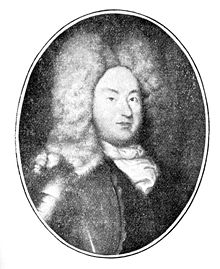Ernst Friedrich I (Saxony-Hildburghausen)
Ernst Friedrich I of Saxony-Hildburghausen (born August 21, 1681 in Arolsen , † March 9, 1724 in Hildburghausen ) from the Ernestine line of the Wettins , was Duke of Saxony-Hildburghausen .
Life
Ernst Friedrich was the eldest son of Duke Ernst von Sachsen-Hildburghausen (1655–1715) from his marriage to Sophie Henriette (1662–1702), daughter of Prince Georg Friedrich von Waldeck zu Eisenberg.
Carefully trained by his mother, who was very close to him, he went on his cavalier tour to Holland, England and France. From 1700 he was first in Dutch and then in imperial military service. He fought as a colonel in the siege of Tönning and as a cavalry general in the battle of Schellenberg . During the War of the Spanish Succession , he was shot in the arm near Höchstädt . Because of his campaigns for the Netherlands, he baptized his firstborn with the name "Hollandinus". In 1708 he was appointed Imperial General Field Sergeant and in 1709 Major General of the States General. 1721 he was by Emperor Karl VI. appointed Imperial Field Marshal Lieutenant.
Ernst Friedrich I. took over the government in 1715 after the death of his father. As a result of completely inadequate court and military pomp, with which he, like many German Duodec princes, wanted to emulate the "Sun King" Louis XIV of France, the country got into considerable financial difficulties. Because of the unbearable tax burden, there was an open revolt in the country in 1717.
Ernst Friedrich built a salt works in Lindenau , as did the Neustadt in Hildburghausen. Here he supported the building of a church for the French Reformed community in 1721.
Constantly in need of money, he sold taxes and parts of the country, including the Geldern county of Cuylenburg , his mother's inheritance. The county was sold to the States General for 800,000 guilders in 1720, but not to pay off the debt, but to move the lavishly designed palace garden with a canal. The Schalkau office was also sold to the Duchy of Saxony-Meiningen in 1723 . The sale was considered illegal in the following custodial government of his wife, which led to the war with Sachsen-Meiningen.
progeny
On February 4, 1704 married Ernst Friedrich I. Erbach Sophia Albertine of Erbach-Erbach , with whom he had the following children:
- Ernst Ludwig Hollandinus (* / † 1704)
- Sophia Amalia Elisabeth (1705–1708)
- Ernst Ludwig Albrecht (* / † 1707)
- Ernst Friedrich II. (1707–1745), Duke of Saxony-Hildburghausen
- ⚭ 1726 Countess Caroline von Erbach-Fürstenau (1700–1758)
- Friedrich August (1709–1710)
- Ludwig Friedrich (1710–1759)
- ⚭ 1749 Princess Christiane Luise of Schleswig-Holstein-Sonderburg-Plön (1713–1778)
- Elisabeth Albertine (1713–1761)
- ⚭ 1735 Duke Karl of Mecklenburg (1708–1752)
- Emanuel Friedrich Karl (1715-1718)
- Elisabeth Sophia (* / † 1717)
- Georg Friedrich Wilhelm (1720–1721)
literature
- Johann Samuelansch (ed.): General Encyclopedia of Sciences and Arts , 1st section, 37th part, Leipzig, 1842, p. 300 ( digitized version )
- Oliver Heyn: The Military of the Principality of Saxony-Hildburghausen (1680-1806) (= Publications of the Historical Commission for Thuringia, Small Series, Vol. 47), Cologne, Weimar, Vienna 2015
- Oliver Heyn: Military prestige and financial security. The Dukes of Saxony-Hildburghausen in the service of the United Netherlands (1680-1760) , in: Zeitschrift für Thüringische Geschichte 71 (2017), pp. 45–72.
- Rudolf Armin Human: Chronicle of the city of Hildburghausen , Hildburghausen, 1886
- Heinrich Ferdinand Schoeppl: The dukes of Saxony-Altenburg. Bolzano, 1917, reprint Altenburg, 1992
Web links
- Ernst Friedrich I Duke of Saxony-Hildburghausen on thepeerage.com , accessed on September 11, 2016.
| predecessor | Office | successor |
|---|---|---|
| serious |
Duke of Saxe-Hildburghausen 1715 - 1724 |
Ernst Friedrich II. |
| personal data | |
|---|---|
| SURNAME | Ernst Friedrich I. |
| ALTERNATIVE NAMES | Sachsen-Hildburghausen, Ernst Friedrich I. von |
| BRIEF DESCRIPTION | Duke of Saxony-Hildburghausen |
| DATE OF BIRTH | August 21, 1681 |
| PLACE OF BIRTH | Arolsen |
| DATE OF DEATH | March 9, 1724 |
| Place of death | Hildburghausen |
